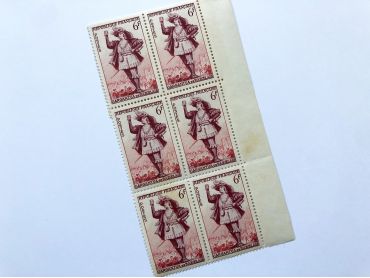
Huge French lottery tickets "Les gueules cassées" from 1937
Huge French lottery tickets "Les gueules cassées" from 1937.
These lottery tickets were sold on the street or in small shops to help veterans.





Block of 6 old French stamps representing Gargantua from 1953. This stamp was created by draughtsman and engraver Henry Cheffer. These stamps have not been used.
Except for digital products, all items are not reproductions, so there may be some wear and tear depending on age what makes it so charming.
Feel free to contact me if you have any questions.
The dimensions and weight of the items offered on this site are expressed in centimeters (cm) and in kilogram (kg).
Here is some information to help you convert them into your own measurement system:
- 10 cm is about 4 inches,
- 1 kg is about 2.2 pounds.
Huge French lottery tickets "Les gueules cassées" from 1937.
These lottery tickets were sold on the street or in small shops to help veterans.
French postcard representing representing two children holding hands with the inscription "Bonne fête" from 1910s. Postcard sent in 1912.
In Europe and probably in other countries, it is tradition to wish a "bonne fête" to relatives and friends according to their first name and the calendar of saints. It is a tradition dating from the 16th century that lasted until the beginning of the 20th century and is gradually being lost.
Vintage Belgian postcard with young girl with her hands joined in prayer from 1910. Postcard sent in 1911.
Very beautiful portrait of a couple - French postcard - 1920s
Vintage French postcard with some roses from 1940s.
Vintage French postcard with a young woman at sunrise and bedtime from 1900s.
Postcard legend: "Bonjour - Bonsoir" / "Hello - Good evening"
Large 24-page French weekly newspaper "Le Gaulois du Dimanche" of May 1909 with beautiful Art Nouveau cover, many articles about history, fashion, arts, literature, music, kitchen, and many engravings and photos.
Le Gaulois is a daily French literary and political newspaper founded on July 5, 1868. It became the property of press boss Arthur Meyer and was published until 1929 before being merged with the Figaro. Due to it large size, this magazine will be sent folded in half.
Huge French lottery tickets "Les gueules cassées" from 1936.
These lottery tickets were sold on the street or in small shops to help veterans.
French postcard entitled "le valet de coeur" (the jack of hearts) from 1900s
Set of 8 French bills of exchange from 1950s with tax stamps and rubber-stamps.
Note that several bills of exchange have a hole in the lower left corner: these bills of exchange had to be stapled to the corresponding bills and had to be detached more or less cleanly once the customer had paid the expected amount.
The last photo shows the back of the bills of exchange.
These bills of exchange are financial instruments for loans between companies. Before the massive arrival of computers, these exchanges were carried out by hand as shown by these documents.
A funny animal illustration by French painter and illustrator Ray-Lambert dating from the 1930s.
Set of 5 pages of philosophy course in French - beautiful writing on the front and back of each sheet.
These sheets were written by a high school student (E. Collin) in 1866.
The page in the last photo is not for sale, it indicates the date of these leaflets.
Each set is very similar to the photos presented and includes 5 leaflets written on the front and back.
Huge vintage map of Europe from a French atlas of the 1910s. This map on two pages measures 54 x 41 cm and forms the front of the document.
On the back you will find a smaller map of the Pacific Ocean (41 x 27 cm) and a hypsometric physical map of Europe (41 x 27 cm) in the 1910s.
At that time Germany was very different from today and Poland was not an independent state.
These maps show the world as it was in 1910s...
Huge French lottery tickets "Les gueules cassées" from 1940 and 1941.
These lottery tickets were sold on the street or in small shops to help veterans.
10 French bills of exchange with beautiful red tax stamps from 1970s.
These bills of exchange are financial instruments for loans between companies. Before the massive arrival of computers, these exchanges were carried out by hand as shown by these documents. The last photos shows the back of the bills of exchange. Each pack is very similar.

Block of 6 old French stamps representing Gargantua from 1953. This stamp was created by draughtsman and engraver Henry Cheffer. These stamps have not been used.
